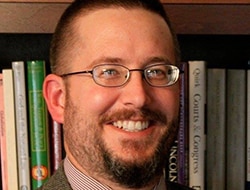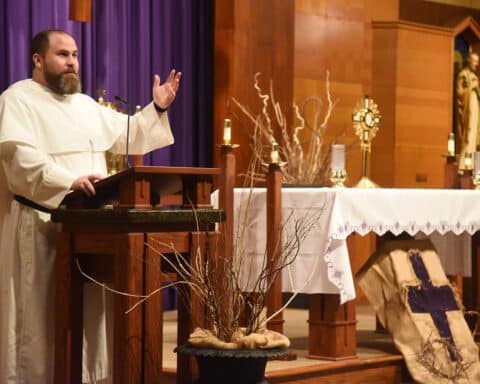
“Presanctified” refers to the previously consecrated bread, reserved from the Sunday liturgy. The faithful gather for a liturgy that is similar to a standard one, but without a consecration, and when the time comes for the distribution of holy Communion, the reserved body of Christ is distributed to the faithful.
In the distant past, the Roman rite practiced something similar during Lent, but today, the last remaining vestige of this practice in the Western Church is the Good Friday liturgy. That liturgy is not a Mass, and the hosts that are distributed on Good Friday were consecrated at the Mass of the Lord’s Supper the evening before.
My wife and I attended Epiphany of Our Lord Byzantine Catholic Church in Annandale, Virginia, for two years before moving back to the Midwest in 1995. I always found the Liturgy of the Presanctified incredibly moving. Even though the faithful receive the Eucharist, there is something profoundly — disturbing? unsettling? — I’m not quite sure what the right word is — about the lack of a consecration during the liturgy.
I’ve felt that way in the Roman rite on Good Friday as well, and the best explanation I can come up with is the sense that, in both the Liturgy of the Presanctified and the Good Friday liturgy, the Eucharist is viaticum — literally, food for the way. “Viaticum” is what we call the Eucharist when the priest brings it to the ill or (especially) the dying. Receiving the Eucharist without a consecration right beforehand seems somehow more somber, a reminder of our own mortality, and, in fact, the practice of the Liturgy of the Presanctified seems to have developed to remind Christians that Lent is a journey through death into life.
This Lent, because of the COVID-19 pandemic, we are all more aware of our mortality — the mortality of each of us and the mortality of all of us. To protect our health and the health of all, Masses have been canceled across the country. For some indeterminate amount of time, the Eucharist will be available for many, if not most, Catholics in the United States only as viaticum. It will be Easter or beyond before most of us receive the Eucharist again.
Late last year, we learned from the Pew Research Center that the majority of Mass-going Catholics do not believe in the Real Presence of Christ in the Eucharist. Those who have observed for many years the difference in the length of lines for holy Communion on Sunday and confession on Saturday were not entirely surprised. Faith is more than intellectual knowledge. It is possible to understand what the Church teaches about transubstantiation and the Real Presence without believing that what the priest holds before your eyes as you approach him for Communion is truly the body, blood, soul and divinity of Jesus Christ, who trampled death by his death on Good Friday and granted life to all who believe in his resurrection on Easter Sunday.
Even Catholics who believe in the Real Presence too often receive the Eucharist by rote. I know I do. Will being deprived of the consolation of the Eucharist for weeks on end change that? Will this be the Lent that makes us regard the Eucharist once again as the source and summit of our lives?
Scott P. Richert is publisher for OSV.





